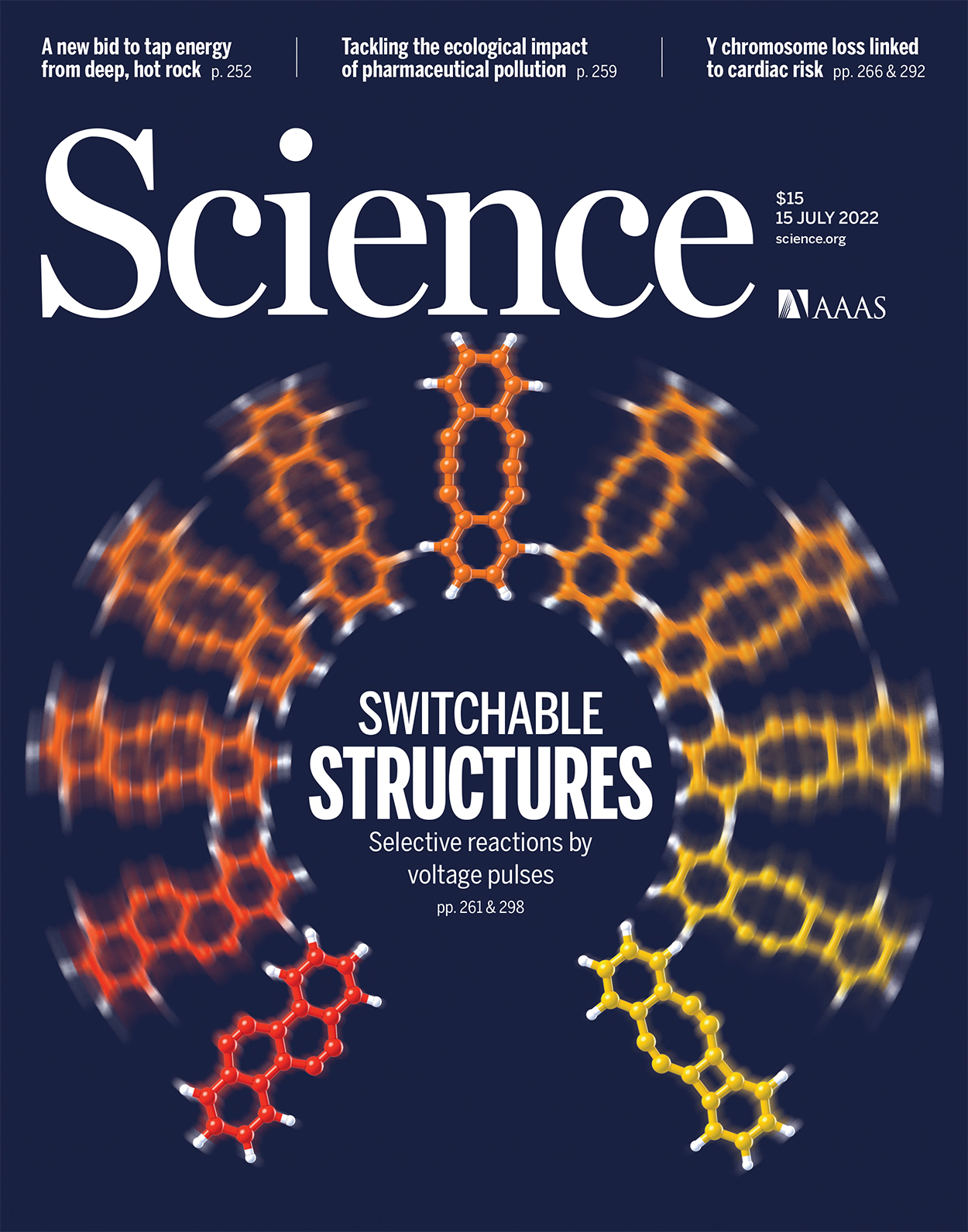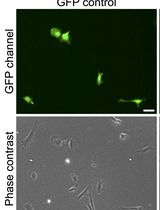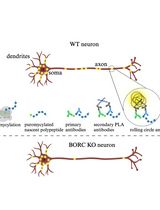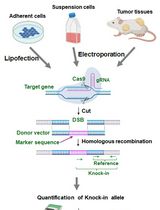- EN - English
- CN - 中文
Development of a Mouse Model of Hematopoietic Loss of Y Chromosome
小鼠Y染色体造血丢失模型的建立
发布: 2023年08月05日第13卷第15期 DOI: 10.21769/BioProtoc.4729 浏览次数: 2044
评审: Gal HaimovichChris TibbittRAVI THAKUR
Abstract
This protocol describes the generation of chimeric mice in which the Y chromosome is deleted from a proportion of blood cells. This model recapitulates the phenomenon of hematopoietic mosaic loss of Y chromosome (mLOY), which is frequently observed in the blood of aged men. To construct mice with hematopoietic Y chromosome loss, lineage-negative cells are isolated from the bone marrow of ROSA26-Cas9 knock-in mice. These cells are transduced with a lentivirus vector encoding a guide RNA (gRNA) that targets multiple repeats of the Y chromosome centromere, effectively removing the Y chromosome. These cells are then transplanted into lethally irradiated wildtype C57BL6 mice. Control gRNAs are designed to target either no specific region or the fourth intron of Actin gene. Transduced cells are tracked by measuring the fraction of blood cells expressing the virally encoded reporter gene tRFP. This model represents a clinically relevant model of hematopoietic mosaic loss of Y chromosome, which can be used to study the impact of mLOY on various age-related diseases.
Graphical overview

Background
Mosaic loss of Y chromosome (mLOY) is the most prevalent post-zygotic mutation in humans (Forsberg et al., 2014). More than 40% of men exhibit appreciable mLOY in hematopoietic cells by the age of 70 years (Thompson et al., 2019). The Y chromosome contains a relatively small number of protein-coding genes, and it can be viewed as a gene desert. Thus, while the phenomenon of mLOY was identified more than half a century ago, it has been regarded as a benign age-related alternation or as a biomarker for aging. However, recent research has found that mLOY in blood cells elevates the risk of all-cause mortality and a variety of human disorders, such as solid cancers, Alzheimer’s disease, and cardiovascular disease (Forsberg et al., 2014; Dumanski et al., 2016; Thompson et al., 2019; Sano et al., 2022). However, due to the descriptive nature of this epidemiological research, it cannot be determined whether mLOY in blood plays a causal role in the development of disease. To address this gap in knowledge, experimental studies can provide insights as to whether mLOY is causally linked to age-related illness.
The reconstitution of the hematopoietic system by the bone marrow transplantation (BMT) of gene-modified cells has been widely employed in mice to study the regulatory mechanisms that control the blood system. Recently, we employed CRISPR/Cas9-mediated gene editing to create mice with targeted mutations in genes to model the phenomenon of clonal hematopoiesis of indeterminate potential. In this method, lineage-negative cells isolated from the bone marrow of Cas9-transgenic mice are transduced with lentivirus vectors that encode gRNAs ex vivo. Hematopoietic lineage-negative cells are comprised of stem/progenitor cells that lack the expression of specific cell surface markers associated with various blood cell lineages. The lineage-negative cell pool has the ability to differentiate into multiple blood cell types. The resulting gene-edited cells are then transplanted into conditioned wildtype mice, achieving an editing efficiency of 90% within the transduced hematopoietic stem and progenitor cells (HSPC). More recently, we employed a similar CRISPR/Cas9 approach to ablate the entire Y chromosome within hematopoietic cells (Sano et al., 2022). In this application, gRNAs were designed to specifically target the repetitive sequences within the Y chromosome, allowing the creation of mice that lacked the Y chromosome in a portion of leukocytes.
Materials and reagents
BD Luer-LokTM disposable syringes, single use, 10 mL (BD, catalog number: 309604)
BD Luer-LokTM disposable syringes, single use, 50 mL (BD, catalog number: 309653)
BD PrecisionGlideTM needle, 18 G (BD, catalog number: 305195)
Insulin syringe, 29 G (EXLINT, catalog number: 26028)
CorningTM FalconTM 50 mL conical centrifuge tubes (Fisher Scientific, catalog number: 14-959-49A)
CorningTM FalconTM 15 mL conical centrifuge tubes (Fisher Scientific, catalog number: 14-959-53A)
Falcon® 100 mm TC-treated cell culture dish (Life Sciences, catalog number: 353003)
Falcon® 6-well clear flat-bottom TC-treated multi-well cell culture plate, with lid (Life Sciences, catalog number: 353046)
Corning® Costar® ultra-low attachment multiple well plate, 6 well (Millipore Sigma, catalog number: CLS3471)
Polypropylene centrifuge tubes (Beckman, catalog number: 326823)
FisherbrandTM sterile cell strainers, 70 μm (Fisher Scientific, catalog number: 22-363-548)
Mouse Millex-HV syringe filter unit
B6 mice (C57BL/6J, The Jackson Laboratory, stock number: 000664, bred in our laboratory or purchased)
Rosa26Cas9 knock-in mouse [B6(C)-Gt(ROSA)26Sorem1.1(CAG-cas9*,-EGFP)Rsky/J, The Jackson Laboratory, stock number: 028555, bred in our laboratory]
pLKO5.sgRNA.EFS.tRFP (Addgene, catalog number: 57823)
psPAX2 (Addgene, catalog number: 12260)
pMD2.G (Addgene, catalog number: 12259)
HEK 293T cell line (ATCC, catalog number: CRL-3216)
Collagen from calf skin (Millipore Sigma, catalog number: C9791)
PEI MAX (Polysciences, catalog number: 24765-1)
Phosphate-buffered saline (PBS), pH 7.4 (Thermo Fisher Scientific, catalog number: 10010023)
Dulbecco’s modified Eagle’s medium (DMEM), high glucose (Millipore Sigma, catalog number: D5796)
RPMI-1640 medium (Millipore Sigma, catalog number: R8758)
StemSpanTM SFEM (STEMCELL Technologies, catalog number: 09600)
Recombinant murine thrombopoietin (TPO) (Peprotech, catalog number: 250-03)
Recombinant murine stem cell factor (SCF) (Peprotech, catalog number: 315-14)
Polybrene infection/transfection reagent (Merck Sigma, catalog number: TR-1003-G)
Penicillin-streptomycin (10,000 U/mL) (Thermo Fisher Scientific, catalog number: 15140122)
Isoflurane liquid inhalation 99.9% (Henry Schein, catalog number: 1182098)
Lineage Cell Depletion kit (Miltenyi Biotec, catalog number: 130-090-858)
Lenti-X qRT-PCR Titration kit (Clontech, catalog number: 631235)
Circular Glass coverslips (12 mm) (Fisher, catalog number: 12-545-80P)
Rubber Cement (Amazon)
Microscope slides (Fisher, catalog number: 12-544-2)
Coplin Jars (glass) (Fisher, catalog number: 08816)
Coplin Jars (plastic) (Market Lab, catalog number: ML9801)
Coverslips, 22 × 50 mm (Fisher, catalog number: 12-518-105EP)
Diamond Tip Scribe (Fisher, catalog number: 08-675)
DNA probes (direct labeled) and validated (Vysis or Cytocell, XqF4/YqA1)
20× SSC (solution) (Fisher, catalog number: BP1325-1)
Purified water, D.I.U.F. (Fisher, catalog number: W2-4)
2× SSC (pH = 7.2) (Cell Line Genetics, in house)
70% ethanol solution (Cell Line Genetics, in house)
85% ethanol solution (Cell Line Genetics, in house)
100% ethanol, 200 Proof (Fisher, catalog number: BP2818-4)
1:20 VectaShield with DAPI (Cell Line Genetics, in house)
1% Formaldehyde (Cell Line Genetics, in house)
0.01 N HCl (Cell Line Genetics, in house)
PBD (phosphate buffered detergent) (Cell Line Genetics, in house)
Pepsin stock solution (Cell Line Genetics, in house)
Recombinant murine SCF (Peprotech, catalog number: 250-03)
Recombinant human IL-11 (Peprotech, catalog number: 200-11)
Recombinant human Flt3-Ligand (Peprotech, catalog number: 300-19)
Recombinant murine IL-3 (Peprotech, catalog number: 213-13)
IMDM (Gibco, catalog number: 12440053)
Doxycycline hyclate (Sigma-Aldrich, catalog number: D9891)
Colcemid Solution (Thermo Fisher, 15212012)
Cell culture media (see Recipes)
Wash buffer for cells (see Recipes)
MACS buffer (see Recipes)
Equipment
Forceps (Fine Science Tools)
Scissors (Fine Science Tools)
Eppendorf® centrifuge 5424R (Millipore Sigma, catalog number: 05-401-205)
Ultracentrifuge (Beckman, model: L8-70M)
Freezer, 4 °C
Deep freezer, -80 °C
Applied BiosystemsTM QuantStudioTM 6 Flex Real-Time PCR System (Thermo Fisher Scientific, catalog number: 4485699)
MACS® MultiStand (Miltenyi Biotec, catalog number: 130-042-303)
LS Columns (Miltenyi Biotec, catalog number: 130-042-401)
QuadroMACSTM Separator (Miltenyi Biotec, catalog number: 30-090-976)
RS-2000 X-ray irradiator (Rad Source Technologies, Inc.)
BD LSRFortessa flow cytometer (BD Biosciences)
Fluorescence microscope (Olympus, catalog number: BX-41)
Appropriate filters matched to excitation and emission spectra of fluorophores used (Chroma, model: Vysis Probes: Spectrum Orange/Spectrum Green, Cytocell Probes: Rhodamine/FITC)
TruTemp DNA micro heating system (Abbott Molecular, model: ThermoBrite)
Stir plate (Fisher, model: Isotemp)
pH meter (Fisher, catalog number: AE150)
Balance (OHaus, catalog number: EP613c)
Water bath (Fisher, model: Isotemp 205)
Quick Spin centrifuge (Fisher, model: Quick Spin)
Software
FlowJoTM software (BD Biosciences)
GraphPad Prism9 (https://www.graphpad.com/scientific-software/prism/)
BioRender (https://biorender.com/)
Procedure
文章信息
版权信息
© 2023 The Author(s); This is an open access article under the CC BY-NC license (https://creativecommons.org/licenses/by-nc/4.0/).
如何引用
Readers should cite both the Bio-protocol article and the original research article where this protocol was used:
- Sano, S. and Walsh, K. (2023). Development of a Mouse Model of Hematopoietic Loss of Y Chromosome. Bio-protocol 13(15): e4729. DOI: 10.21769/BioProtoc.4729.
- Sano, S., Horitani, K., Ogawa, H., Halvardson, J., Chavkin, N. W., Wang, Y., Sano, M., Mattisson, J., Hata, A., Danielsson, M., et al. (2022). Hematopoietic loss of Y chromosome leads to cardiac fibrosis and heart failure mortality. Science 377(6603): 292-297.
分类
发育生物学 > 细胞生长和命运决定 > 成熟衰老
发育生物学 > 基因组编辑
分子生物学 > DNA > 染色体工程
您对这篇实验方法有问题吗?
在此处发布您的问题,我们将邀请本文作者来回答。同时,我们会将您的问题发布到Bio-protocol Exchange,以便寻求社区成员的帮助。
Share
Bluesky
X
Copy link













